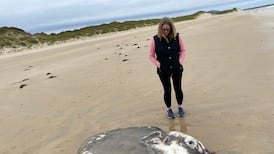Irish men and women who died at Gallipoli and elsewhere during the first World War while serving with the Australian and
New Zealand
armies are being remembered at a special ceremony today in Dublin as
Australia
itself, and Australians around the world, mark
Anzac Day
.
The Irish who died, about 900 from a contingent of some 6,500, were men and women who had emigrated, mainly to Australia, or were visiting there or New Zealand when the war began and, rather than returning home, enlisted where they were.
For the 900, theirs was the fate that awaited nearly 11,500 Anzac troops – 8,709 from Australia, 2,721 from New Zealand – who died in the Dardanelles, having landed at Gallipoli on April 25th, 1915.
Their battle with Turkish forces of the Ottoman Empire was a catastrophic failure costing about 100,000 lives in all and they, together with Allied soldiers from Britain (including Ireland) and France, spent the rest of the year bogged down before retreating in December.
The high death toll on April 25th and in the days immediately after convulsed Australia and Anzac Day, which began with spontaneous acts of remembrance in Australia, has evolved into a day of remembrance there for Australians who have died in all wars and peacekeeping operations since.
Service of remembrance
A dawn service of remembrance at Grangegorman Military Cemetery was due to be attended this morning by Ruth Adler, the Australian ambassador to Ireland; Kenneth Ryan, first secretary of the New Zealand embassy; Zeki Güler, counsellor at the Turkish embassy; representatives of the Irish, Australian and New Zealand defence forces; and Prof Jeff Kildea, this year's Keith Cameron Professor of Australian History at UCD, who gave the oration.
Yesterday, Prof Kildea spoke of the Irish who died while serving with Anzac forces.
"They were a mixed bag," he told The Irish Times , "miners, labourers, rural workers, teachers and some professionals. They lived all over but especially in western Australia where there was much mining and passenger ferries often landed first at Fremantle [near Perth]."
In his oration, he mentioned 13 of the 900 Irish who died: Michael Brown of Cork, William Calderwood of Belfast, Patrick Foley of Wexford, Charles George Gordon of Kingstown (now Dún Laoghaire), David Hawkins of Letterkenny, Patrick Kiely of Cork, Frederick Dennis Mangan of Dublin, Patrick McDonnell of Bruff, Co Limerick, Robert Douglas Niblock of Belfast, John Mullan of Limavady, Co Derry, William Henry Munro from Derry city, William Miller Smylie of Belfast, and Albert George Stapleton of Dublin.
Anzac Cove
This disparate group of men chosen at random but who died on April 25th, 1915, at Anzac Cove and Cape Helles, had come to Australia "to pursue a new life in a young country removed from the persistent problems of the old, only to be flung back into the vortex of old-world rivalries".
He continued: “In Australia, the facade of denominational unity cracked in the wake of the Easter Rising. Thereafter, the Irish in Australia would be maligned as shirkers, Sinn Féiners and pro-German. Among those propagating that view was the Australian prime minister William Morris Hughes, who in March 1917 wrote to British prime minister Lloyd George that “the non-Irish population are going out of Australia to fight . . . [The Irish] remain behind”.
“Yet we now know, and it was known at the time, that the Irish in Australia did pull their weight, enlisting generally in line with their proportion of the population and, if you take into account enlistment age, more than their proportion. Recent research has exposed their denigration for the calumny it was, though it continues to linger in some quarters even to this day.”
While the 6,500 were overwhelmingly men, they included an estimated 34 women, almost all of them nurses. One who never made it home – either to Ireland or Australia – was Nurse Kathleen Powers from Piltown in Kilkenny, who, tending the wounded at a hospital in Bombay, succumbed to cholera in 1916, aged 28.
Prof Kildea is compiling an online archive of the 6,500 Irish who served in the Anzac forces and it will be published next October.











